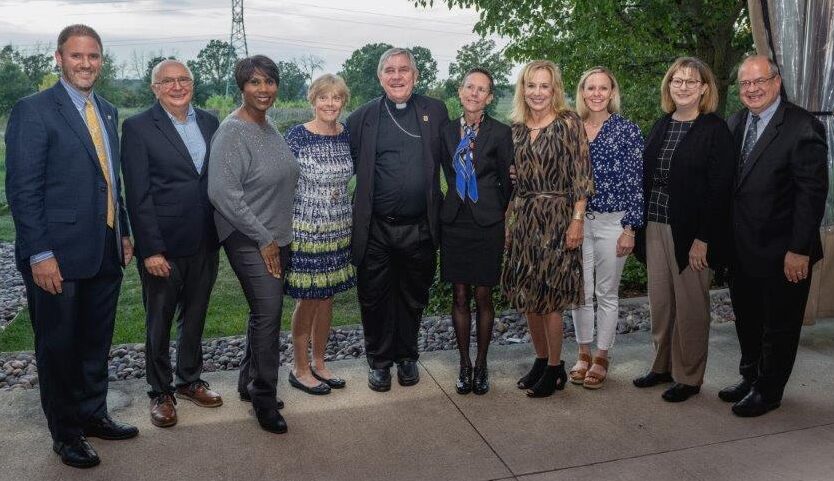
Pictured at Catholic Relief Services’ Archbishop’s Annual Reception are (from left) Tony Pohlen, Art Wigchers, Portia Young, Sue Schmitt, Archbishop Jerome E. Listecki, Jennifer Poidatz, Kay Redmond, Kathy Durand, Susan McNeil and Carl Holborn. (Submitted photo)
Who does Catholic Relief Services help?
In his mind’s eye, when Carl Holborn pictures the answer to that question, he sees a young girl with a vacant look in her eyes and a young child in her arms.
Holborn, a Milwaukee attorney who is a longtime donor and supporter of Catholic Relief Services, has traveled overseas several times to witness firsthand the life-saving work being done by the official humanitarian organization of the United States Conference of Catholic Bishops.
On one of those trips, he found himself in a refugee camp in Iraq, filled with people whose lives and communities had been destroyed by the terrorist attacks of ISIS.
One of them was a young Yazidi girl, a member of a religion targeted specifically by ISIS. She was perhaps 15 or 16 years of age, Holborn recalled, and she had a “distant” look in her eyes — more so even than the other traumatized refugees.
“She just seemed sort of lost,” he said.
He learned that the girl’s village had been raided by ISIS forces, who had then kidnapped, enslaved and raped her. She became pregnant, and though she was eventually freed from captivity, upon returning to her village, her child was rejected. She could stay, said her family and friends, but the baby, fathered by a terrorist, could not. So she came to be at this refugee camp, with only CRS to help her.
“CRS helps the poorest of the poor,” said Holborn. “The world’s most vulnerable human beings.”
Holborn shared this story with attendees of the Archbishop’s Annual Reception for Catholic Relief Services, which took place in late September at the Sharon Lynne Wilson Center in Brookfield.
The theme of the evening was “Hope When Disaster Strikes,” with a focus on the relief work done by CRS in times of natural or man-made disaster. In addition to Holborn’s remarks, attendees heard from Jennifer Poidatz, CRS Vice President for Humanitarian Response; John Borgen, CEO of Catholic Financial Life, a presenting sponsor of the event; and Archbishop Jerome E. Listecki. Portia Young served as the master of ceremonies.
Those who have seen with their own eyes the impact CRS has in areas of the world devastated by war and natural disaster know that the support the organization receives from donors is crucial. That’s why the Archbishop’s Annual Reception is such an important event to the community who supports CRS, said Art Wigchers, a member of the organizing committee and a longtime CRS supporter who founded the event in 2007.
“You can’t help something you aren’t aware of,” he said. Wigchers continued that what is important for people to know about CRS staff is that they are “exceptional” at assisting victims of “man-made” and natural disasters because they already have staff on the ground in most areas of the world, and they understand the culture.
The reception began as a gathering to thank donors for their support and to keep them apprised of the work CRS is doing around the globe. It has also been a golden opportunity to introduce the mission of CRS to new people.
“I think the best-kept — or maybe worst-kept — secret of CRS is that so many American Catholics are not aware of what CRS is and what it does,” said Sue Schmitt, chair of the organizing committee. “That’s the challenge — to spread the word. And that’s another main reason we had this event.”
The dinner got its start when Art Wigchers met with then-Archbishop Timothy Dolan to propose an evening of recognition and awareness-raising. The first reception was held in the cafeteria of the seminary, he said, and had about 50 guests.
“Gradually, as we invited more people, we not only thanked our donors but moved toward an ask and raising funds,” said Kay Redmond, a member of the reception’s organizing committee. “One of my goals this year was to invite new folks who were not familiar with CRS and to invite non-Catholics since CRS works (with people) regardless of religion or creed.”
Redmond’s own involvement with CRS dates to an event similar to the Archbishop’s Annual Reception. In 2009, she was invited to a luncheon given by the organization, and she was so moved by the speaker that she accepted a further invitation to travel to India with CRS. The experience transformed her.
“Over the past 14 years, I have gotten to know CRS intimately — and to know CRS is to love it deeply,” she said.
“CRS has a unique ability to reach into these communities in these foreign countries because it leverages the relationship that the Church as a whole has,” Holborn pointed out. “That’s what makes it so efficient. It makes it so that every dollar you give is just specifically directed for the people in need. We want to make sure we get the word out on that, and that’s what we’re trying to do with this reception.”
CRS was formed in 1943 by the United States Conference of Catholic Bishops to administer humanitarian aid to survivors of World War II in Europe. The organization now ministers to more than 130 million people in more than 100 countries on five continents.
In addition to emergencies, Redmond pointed out CRS works with local partners and communities on the ground to find long-term solutions to poverty. “They work on addressing root causes of global hunger, youth unemployment, lack of health and education opportunities and agriculture,” she said. “CRS works to instill dignity.”
For more information about the mission of Catholic Relief Services, visit crs.org.
